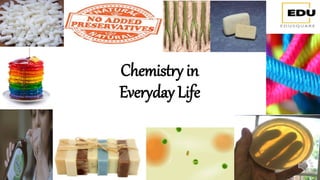
Chemistry in Everyday Life.pptx
- 2. Everyday Chemicals Cleanliness: Soaps, Detergents, Bleaches, Toothpaste, Nail Polish Remover Clothes: Synthetic Fibers, Coloring Chemicals Food Material: Fertilizers, Pesticides, Chemical Sweeteners. Preservatives Medicines, Explosives, Fuels, Rocket Propellents, And many more……
- 3. Classification of Drugs Pharmacological Effect Drug Action Chemical Structure Molecular Targets Classified on the basis of the physiological effect on our body For example: Anti-pyretic: used to reduce body temperature Anti-septic : used to kill or arrest bacteria growth Based on the action of a drug on a particular biochemical process For example: Anti-histamines: Inhibit the action of the compound, histamine which causes inflammation in the body Based on the chemical structure of the drug. Drugs classified in this way share common structural features and often have similar pharmacological activity For example: Sulphonamides: can suppress multiplication of micro- organisms. Therefore used as anti bacterial Drugs usually interact with biomolecules such as carbohydrates, lipids, proteins and nucleic acids. These are called target molecules or drug targets. Drugs possessing some common structural features may have the same mechanism of action on targets.
- 4. Drug Designing Two Main considerations while designing a drug Drug Target Drugs interact with macro molecules such as proteins, carbohydrates, lipids and nucleic acids called targets Correct choice of drug target is important to obtain good therapeutic effect Drug Metabolism Drug travels through the body to reach its target Should reach the target without getting metabolized in between. After its action, drug and its metabolites are excreted without causing harm to the body
- 5. Enzyme as Drug Target Catalytic action of enzymes: In their catalytic activity, enzymes perform two major functions: Active sites of enzymes hold the substrate molecule in a suitable position, so that it can be attacked by the reagent effectively. Substrates bind to the active site of the enzyme through a variety of interactions such as ionic bonding, hydrogen bonding, van der Waals interaction or dipole-dipole interaction The second function is to provide functional groups that will attack the substrate and carry out chemical reaction.
- 6. Drug – Enzyme Interaction Drugs can block the binding site of the enzyme and prevent the binding of substrate, or can inhibit the catalytic activity of the enzyme. Such drugs are called enzyme inhibitors Non Specific Inhibition Some drugs do not bind to the enzyme’s active site. These bind to a different site of enzyme which is called allosteric site. This binding of inhibitor at allosteric site changes the shape of the active site in such a way that substrate cannot recognize it
- 7. Receptor as Drug Target Receptors are proteins that recognize & respond to body’s own chemical messengers such as hormones and neurotransmitters Majority of these are embedded in cell membranes in such a way that their small part possessing active site projects out of the surface of the membrane. There are a large number of different receptors in the body that interact with different chemical messengers. These receptors show selectivity for one chemical messenger over the other because their binding sites have different shape, structure and amino acid composition Drugs that bind to the receptor site and inhibit its natural function are called antagonists. These are useful when blocking of message is required. Drugs that mimic the natural messenger by switching on the receptor, these are called agonists. These are useful when there is lack of natural chemical messenger
- 8. Therapeutic action of different classes of drugs
- 9. Antacids: Over production of acid in the stomach causes irritation and pain. Until 1970, only treatment for acidity was administration of antacids, such as NaHCO3 or a mixture of Al(OH)3 and Mg(OH)2. Excessive hydrogencarbonate can make the stomach alkaline and trigger the production of even more acid. Metal hydroxides are better alternatives because of being insoluble, these do not increase the pH above neutrality. Drug cimetidine (Tegamet), was designed to prevent the interaction of histamine with the receptors present in the stomach wall. This resulted in release of lesser amount of acid. Importance of the drug was so much that it remained largest selling drug in world until another drug, ranitidine (Zantac), was discovered.
- 10. Anti-histamines Histamine is a potent vasodilator (group of medicines that dilate (open) blood vessels). It has various functions. It contracts the smooth muscles in the bronchi and gut and relaxes other muscles, such as those in the walls of fine blood vessels Histamine is also responsible for the nasal congestion associated with common cold and allergic response to pollen Synthetic drugs, brompheniramine (Dimetapp) and terfenadine (Seldane), act as anti-histamines. They interfere with the natural action of histamine by competing with histamine for binding sites of receptor where histamine exerts its effect Why do above mentioned anti-histamines not affect the secretion of acid in stomach?” The reason is that antiallergic and antacid drugs work on different receptors Histamine
- 11. Why do soaps not work in hard water? • Hard water contains calcium and magnesium ions. These ions form insoluble calcium and magnesium soaps respectively when sodium or potassium soaps are dissolved in hard water • These insoluble soaps separate as scum in water and are useless as cleansing agent • In fact these are hindrance to good washing, because the precipitate adheres onto the fiber of the cloth as gummy mass • Hair washed with hard water looks dull because of this sticky precipitate • Dye does not absorb evenly on cloth washed with soap using hard water, because of this gummy mass